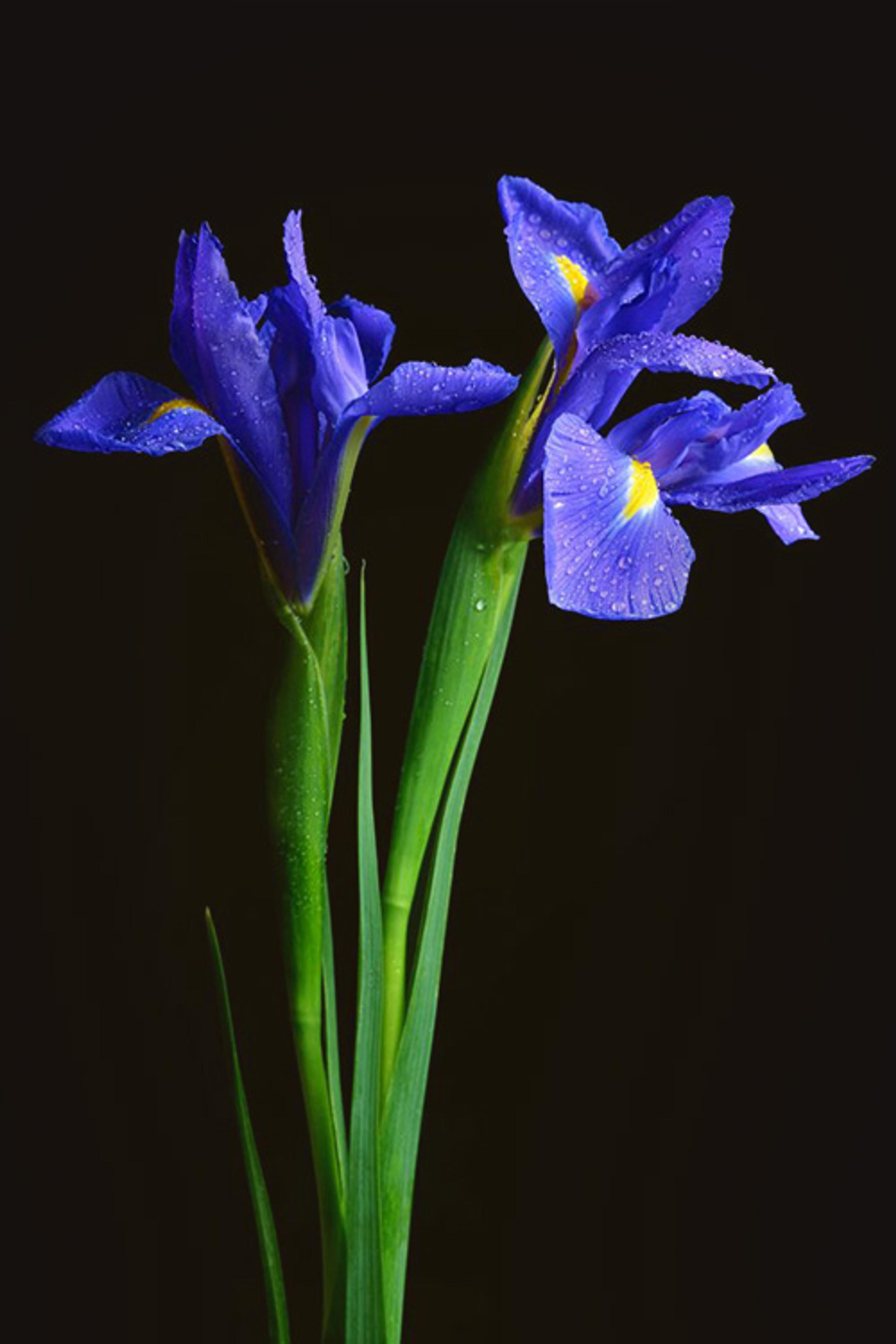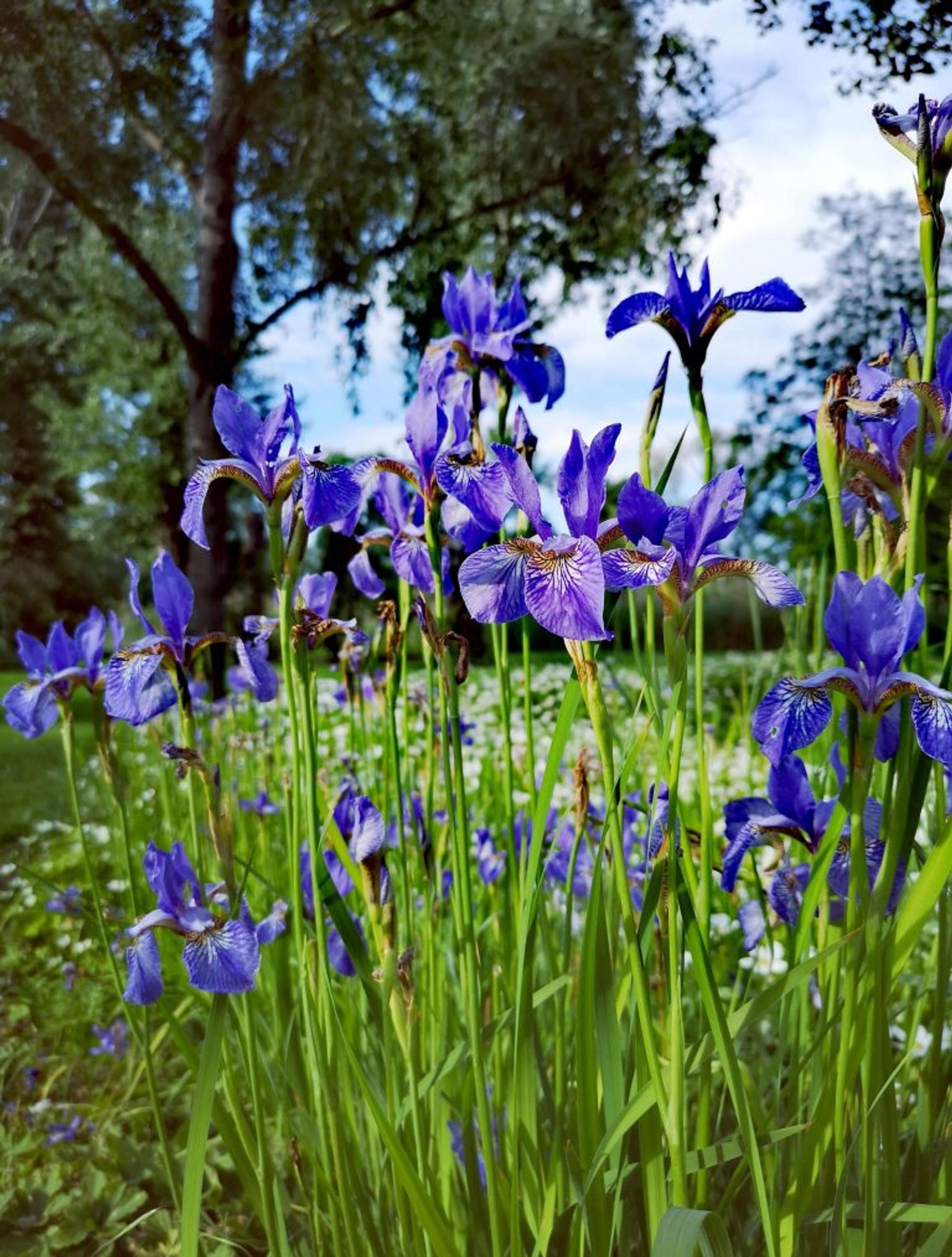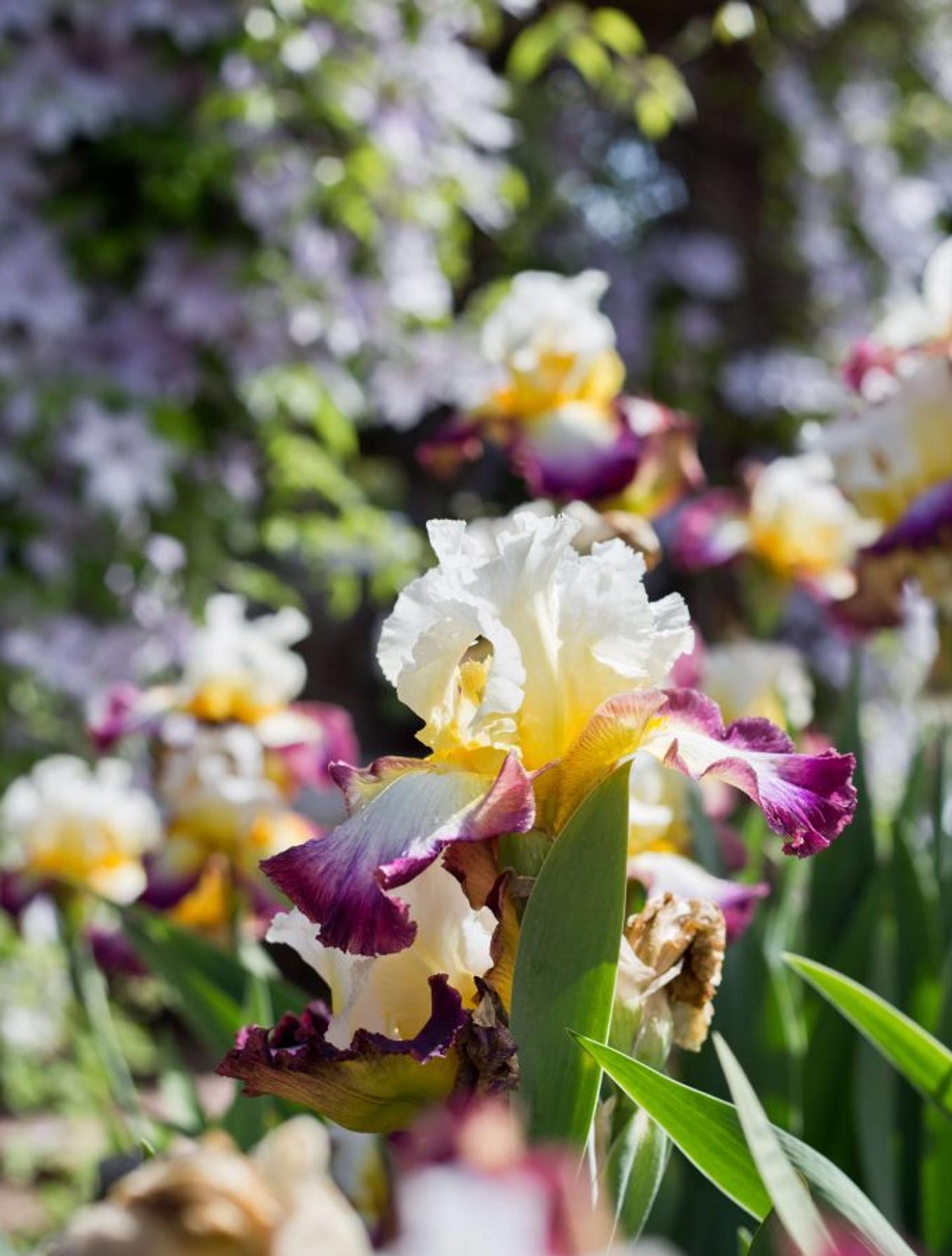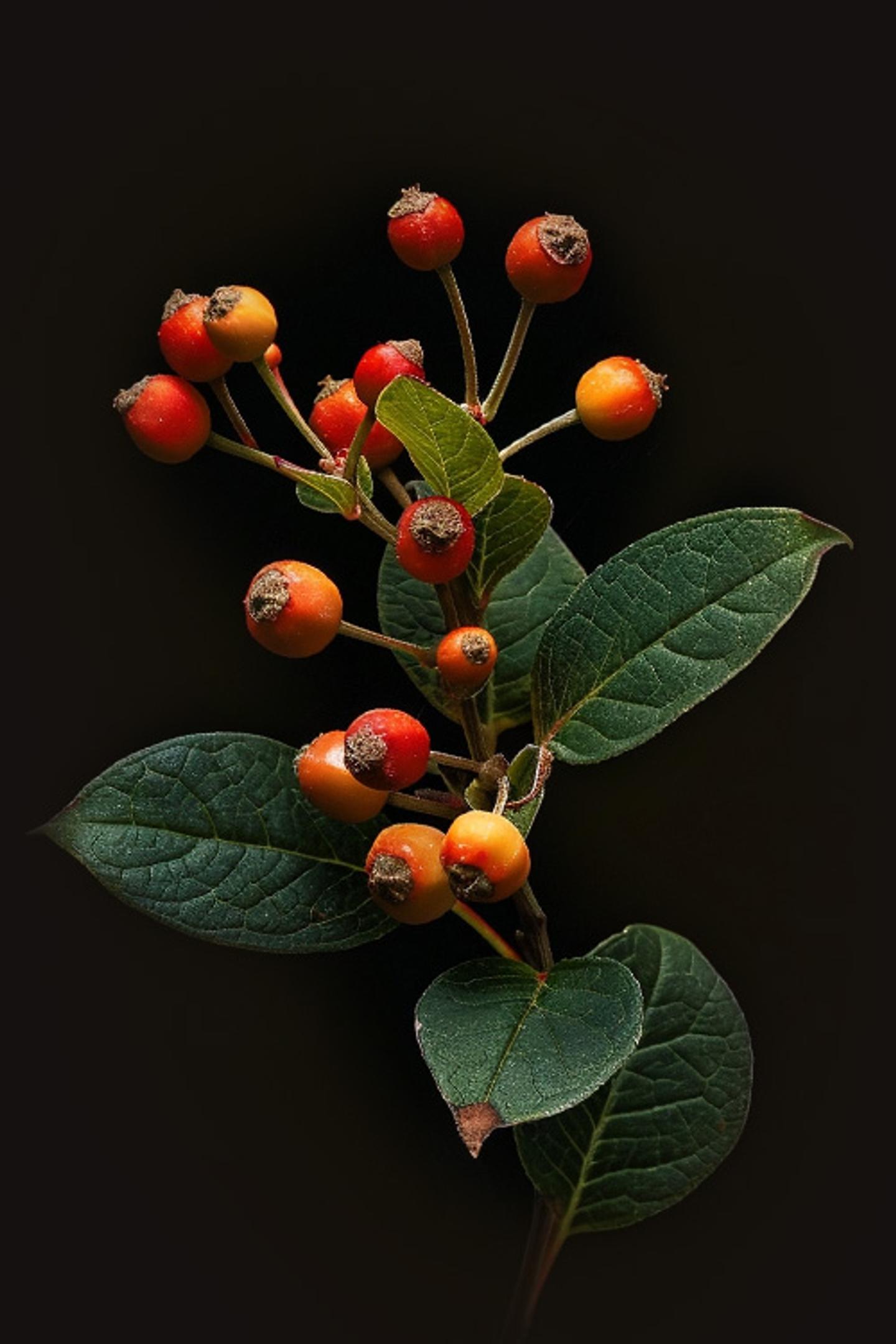Flower Meanings
Iris


The Meanings of Irises
Just like your favorite shoes, irises come in many colors, each just as beautiful as the next. The ancient Greeks saw the rainbow as the robes of the goddess Iris, with some believing the multi-colored flowers were part of her robe. Others saw it as the veil from her dress. [1]
The rainbow flower is widely considered the symbol of communication and messages, due to the goddess, Iris, being the Greek goddess for the Messenger of Love.
The traditional purple iris represents wisdom, courage, respect, and admiration. Not surprisingly, then, it has also come to symbolize royalty, a common association with the color purple.
The beautiful blue iris symbolizes faith, hope, trust and pixie dust. Oh no, wait… that last one is something else. But who would argue that its dazzling magic fits here?
Is it passion you’re looking for? Look no further than a yellow iris. Delicate and tall, the yellow iris could make anyone catch all the feels at a glance.
As with many white flowers, the white iris symbolizes purity and innocence. It is often found in mixed bridal bouquets, due to their smaller size and striking appearance. Small in size, yes, but never to be underestimated in terms of its effect.
So knowing the meanings of the individual colors also helps when putting a bouquet together. With this knowledge, you can mix and match meanings into a cohesive whole, combining purity with respect, hope, and passion, or whatever other heady combination speaks best for you — or perhaps your union with a partner.
Let’s face it, you have many moods and meanings — so express yourself!
What Do Irises Smell Like?
Irises have a buttery-soft, smooth scent. It’s often describes as a powdery aroma that replicates that of fresh bread—yum! [5]
February Birth Flower
Iris are synonymous with affection and devotion making them the perfect alternative to roses for Valentine’s or a stunning February birthday gift.

"Then we had the irises, rising beautiful and cool on their tall stalks, like blown glass, like pastel water momentarily frozen in a splash."
Margaret Atwood
The History of the Iris
Ready for the iris category of Jeopardy? Let’s play!
The iris is the state flower of Tennessee, and boy are they proud of it! Many streets, town centers and even eateries are named after the flower. [2]
Iris is the name of the Greek goddess of rainbows. In ancient times, men would plant irises by the graves of women to call to the goddess and ask her to walk their souls across the “rainbow bridge” – also where that term comes from! The meanings of irises (see section above), became symbolic of the French monarchy in the middle ages, leading to the Fleur-de-lis becoming recognized as the national symbol of France. [3] According to French legend, the above fact was helped by a dream that King Louis the VII had in 1147, in which he was commanded to adopt the blue iris as the national flower. The king was so overwhelmed by the dream that he had the iris carved into his coat of arms; in 1179 he ordered the use of fleur-de-lis clothing in his son Philip’s coronation.
Ancient Egyptian kings were enthralled by the iris and its exotic appeal. Drawings of the flower have been found in many Egyptian palaces, helping make its celebrated connection to royalty extremely powerful. A flower on the Sphinx is thought by many to be an iris; while another appears on a bas-relief from the 18th Egyptian dynasty.
The iris is the birth-month flower for February, appropriately matching the beautiful purple amethyst stone also associated with the month.
Irises have been used for various purposes throughout history: French peasants planted irises on the edges of their thatched roofs to prevent erosion; irises were prescribed by Apothecaries as a remedy to digestive problems; and the root was blended into cough syrups and antitussive teas. Ancient cultures utilized iris oils in their perfumes, furthering the stature of this regal plant.
Examples of iris based perfumes today include: Iris Nobile Acqua di Parma; Iris Ganache Guerlain; and Iris Silver Mist Serge Lutens. Possibly next only to the rose, the iris flower is a favorite subject of great art, appearing in masterpieces by painters such as: Leonardo da Vinci, Cezanne, Renoir, Claude Monet, Gauguin, and Van Gogh.
DID YOU KNOW - Iris Fun Fact
Vincent Van Gogh painted his famous iris painting, appropriately named Irises, while in an asylum. It was his first of several that he painted while there, and one of his only paintings made during that time, expressed with a joyous and adorning tone.

Iris Biology
The Iris genus comprises 200-300 species of flowering plants known, of course, for their stunningly beautiful flowers. There are two Iris varieties: rhizomes (rhizomatous) and bulbous (growing from bulbs). From here, the Iris genus is usually split into subgenii formed from those characteristics, along with the appearance of beards [4] — namely, a fuzzy midsection.
Native growth takes place in virtually all temperate zones, including Europe, North Africa, parts of Asia, North America, and the Mediterranean area.
Petals and sepals have their own special names in the world of iris flowers. The outer three sepals are called falls, while the outer three petals are called standards. They make the flower beautiful and graceful, but also serve a purpose.
Rhizome irises have thickened stems that grow horizontally, either partially underground or completely underground. Three very popular irises from this group are named Bearded, Beardless, and Crested.
Bulbous irises grow from bulbs requiring a period of dormancy after blooming. These are typically smaller than rhizome irises and usually produce smaller blossoms.
Because the iris flower is so well-formed for pollination, the falls act as landing pads for pollinators, creating easy access for bees and hummingbirds alike!
Grown from both seed and root separation, pollination occurs from the irises’ own anthers, or as a result of cross-pollination from another plant. Rhizomatous irises can be reproduced asexually simply by cutting a section from the rhizome.
The yellow iris is used widely in pond purification, as its roots uptake agricultural runoff and therefore improve water quality.
The leaves of the iris flower are typically erect and sword-shaped. The flowers are highly symmetrical, which only adds to their legendary beauty.
With such a large number of species, and such intense interest in just a few, it’s possible that flower lovers know fewer of these stunning flowers than perhaps any other popular group.
DID YOU KNOW - Iris Fun Fact
One of the largest iris gardens in the world is located in Florence, Italy.

How to Care for Irises
Typically, cut irises last 3-6 days, but by using the flower food packet that your florist will include with them, and placing them in a cool location with indirect sunlight, they can last longer. The flower food will provide healthy nutrients that also inhibit the growth of microorganisms.
Because of their beautiful stems and sword-like leaves, they often look best in a clear vase.
Ideally, your irises will have been cut after the blossoms formed and started to color, and before the blooms have opened. Your florist will cut them at a 45-degree angle so they can absorb plenty of water.
Your clear vase should be washed with a solution made up of antibacterial soap and warm water. This should remove any potentially harmful bacteria from the vase. Once dried, pour your flower food into the vase. Remove any leaves that fall below the water line and arrange your irises. Show off those stems!
After three days, trim another inch from the stems and replace your flower food. Remember to trim at that 45-degree angle for improved water absorption. This will help prevent a cloudy effect, and/or stagnation, and can extend the life of your flowers.
When to Send Irises as a Gift
Need a gift? Why not an iris?! They make the perfect gift for a variety of occasions. A white or blue iris is a great christening gift — after all, how many children’s versions of Noah’s Ark does a household need? In need of a housewarming gift? Plantable irises are hearty and can grow in a variety of soils, so you don’t need to be familiar with the new house to give a great gift! One of the hardest gifts to come up with, yet it sneaks up on us every year, is a teacher appreciation gift. Since the purple iris symbolizes wisdom, and respect, a bouquet of them makes a great gift to show teachers you appreciate all the hard work they do.

References:
- 1 - TheOI.com
- 2 - State Symbols
- 3 - Travel France
- 4 - Iris Wiki
- 5 - Experimental Perfume Club
Flower Meanings — keep discovering

Holly
Have a holly jolly Christmas! With it’s shiny, prickly leaves and bright red berries, holly is undoubtedly a Christmas favorite. But that doesn’t mean we can’t enjoy them all year round!

Hyacinth
Ah, the sweet smelling loveliness of the hyacinth. We all know this beautiful bloom for its to-die-for light and airy fragrance we wish we could bottle up and wear as a perfume. But the hyacinth also has a jam-packed history and symbolism that is full of decadence and the tragedy of love.

Hydrangea
What are those giant bushes covered in perfumed blue and pink clusters of flowers? Why hydrangeas, of course! Just as popular in bridal bouquets as adorning your country home, these blooms are nothing if not versatile.

Hypericum Berries
Hypericum, otherwise known as the gift that keeps on giving. Why? After they’ve finished flowering, they produce beautiful, festive berries!

Holly
Have a holly jolly Christmas! With it’s shiny, prickly leaves and bright red berries, holly is undoubtedly a Christmas favorite. But that doesn’t mean we can’t enjoy them all year round!

Hyacinth
Ah, the sweet smelling loveliness of the hyacinth. We all know this beautiful bloom for its to-die-for light and airy fragrance we wish we could bottle up and wear as a perfume. But the hyacinth also has a jam-packed history and symbolism that is full of decadence and the tragedy of love.

Hydrangea
What are those giant bushes covered in perfumed blue and pink clusters of flowers? Why hydrangeas, of course! Just as popular in bridal bouquets as adorning your country home, these blooms are nothing if not versatile.

Hypericum Berries
Hypericum, otherwise known as the gift that keeps on giving. Why? After they’ve finished flowering, they produce beautiful, festive berries!
Ready to send beautiful flowers?
Our guided experience helps you send a one-of-a-kind arrangement perfect for every occasion.
Send Flowers